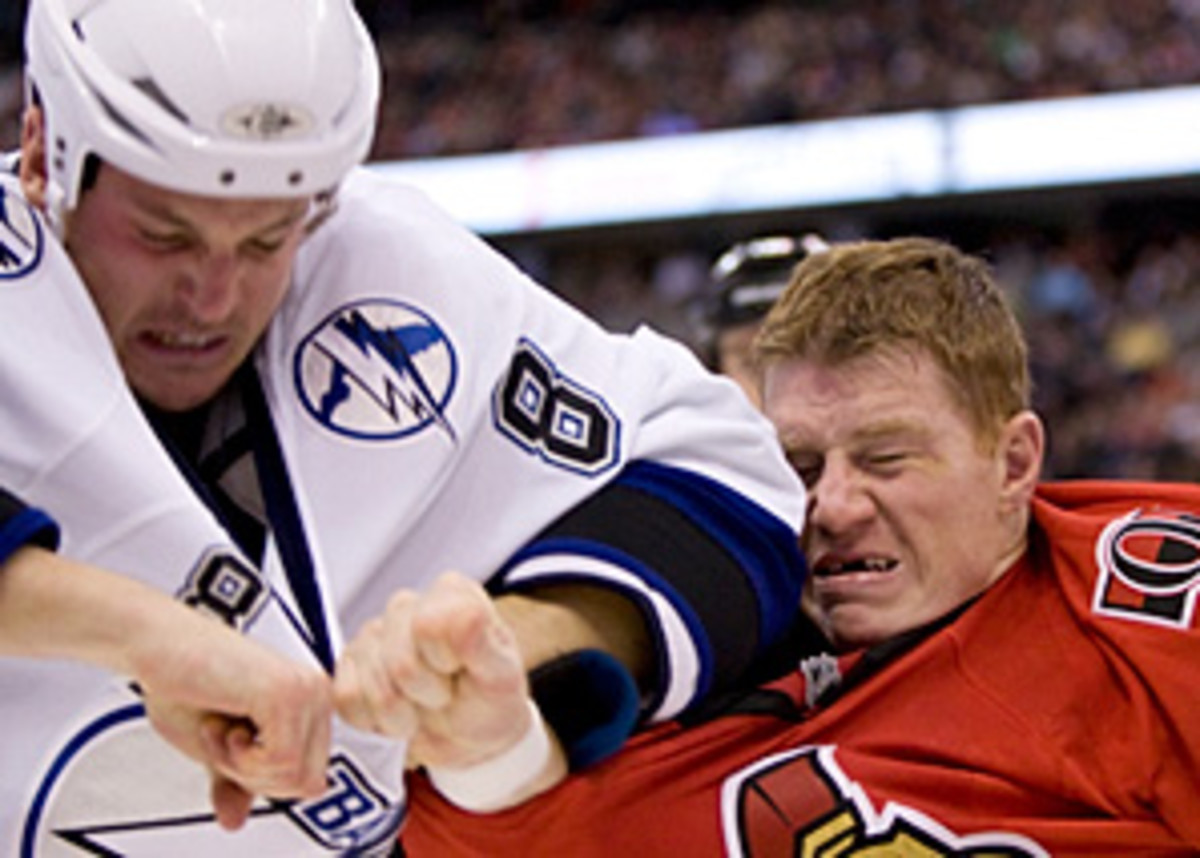NHLPA fiddles as ferocious hits devastate players
These are heady times for the NHL, unfortunately not of the halcyon days variety. No, the start to this season is all about headshots and what to do. So far, there's been only head-scratching over the ongoing NHLPA mess and head-shaking about officiating that seems to be okay with much more contact away from the puck than has been the case during the past four seasons.
With an early rash of bodychecks resulting in shoulders-to-the-head, like the one delivered by the Flyers' Mike Richards that left the Panthers' David Booth concussed and hospitalized, there are no easy answers. A bodycheck delivered with a shoulder in and of itself is legal, which is where the gray begins. The pace of play is swift every shift, with players tracking back defensively as fervently as they skate on the attack. As a result, spacing on both offense and defense has evolved, with more bigger, faster players in closer proximity than ever before, thus blurring the issue further.
Here's what I mean:
If Booth comes across the offensive blueline in 1989, the pass to his teammate on the wing might have been 15 feet rather than eight, and Richards would not have been backchecking with the same sense of purpose. There would have been more time to react after making the pass, and if Richards still delivered the check, it would have obviously been late due to the length of the pass. No question, a dirty hit.
Under 2009 conditions, that conclusion isn't as apparent. Booth's pass is shorter and Richards is closer. Both are moving faster. Add it all together and there is almost no time for Booth to disengage from the act of passing and for Richards to rethink his defending tactic.
The other contributing factor is the equipment. Shoulder pads are bigger, sit higher, and have hard plastic caps on top. That design increases the likelihood of shoulder-to-head contact, and with more surface area being firm rather than flexible, the impact is more jarring. The NHL modified its elbow pad design a few seasons ago for the very same reason, so certainly the same needs to happen with shoulder pads. In fact, in an interview last week, Senior Executive VP & Director of Hockey Operations Colin Campbell said the league has submitted design adjustments for this very issue, but is having a tough time getting the NHLPA to sign off on the changes.
No one should be surprised there.
The NHLPA has left everyone in the game wondering in recent months. Everyone is in charge of the players' union, yet no one is in charge. There have been late-night coups and endless resignations. Now a review committee of Chris Chelios, Nicklas Lidstrom, Mark Recchi and Rob Blake is supposed to makes sense of all the internal nonsense that has been going on... while they conduct their own on-ice business as well. In the meantime, the NHLPA will go with an interim executive director and general counsel until the review committee can convene on a conference call, oh, let's make it November 9. No rush.
The NHLPA has already proved that haste makes waste. Hopefully, the committee is taking the time between now and then to clear the way to reinstate Paul Kelly and put it to a vote immediately. It won't end the chaos, but it is the right course of action to get moving forward and correct an egregious injustice.
Speaking of justice, no one has it tougher than the NHL officials when it comes to sorting and meting it out. The game is fast. The players are big. They now cluster and bunch together like never before. Maintaining clear sightlines is harder than ever -- even with two sets of eyeballs. Yet, while taking all that into consideration, it seems to me that the referees are tolerating more contact away from the puck. Defensemen are sticking and pinning players on the boards once the puck has moved a beat or two longer than was the case when the league declared the new standard of enforcement in 2005-06.
In open ice, I've seen more moving and subtle picks than I can ever remember. The focus on such face-off infractions seems intact, but defensemen screening off for their partners, wingers taking a route to the boards that impedes a forechecker's progress and proximity, picks at the blueline that open up lanes for zone entry, all appear to be more prevalent. Part of it is certainly coaches and players coming up with ways to be as successful as possible now that they've operated under these conditions for the past four seasons. Maybe it is just part of the natural cycle whereby it is now back on the officials to adjust to the adjustments made by the teams.
With Stephen Walkom back in the ranks of on-ice officials, it is up to his replacement Terry Gregson to figure out if in fact the standard is slipping, or is it time to reassess due to the subtle adjustments apparent around the league made by coaches and players alike.
It's Gregson's headache now.

































